Executive Summary
Being a financial advisor is complex, whether in an employee role working with clients, or as an entrepreneur building an advisory firm. Success requires drawing on a wide range of strengths and talents, to the point that as an advisory firm grows, it’s eventually necessary to hire more people and build teams to round out the services provided and ensure that everything is getting done that needs to be done.
Unfortunately, though, for many advisors building a team is difficult, for the simple reason that as human beings we tend to like and build rapport with those who are very similar to us… yet in most cases, the best hires we can make (or partners we can work with) are those who have complementary skills that support us, not a skillset that merely duplicates what we already do. In other words, the people we tend to most want to hire are the people just like us who we should really not be hiring (unless you're really, truly trying to hire your replacement)!
Accordingly, an increasingly common “best practice” for hiring and building teams is to use various types of “personality profiles” – assessment tools that help us to better understand our strengths and weaknesses, and the strengths and weaknesses of others, to build teams where the whole can be worth more than the sum of the parts.
At the same time, though, personality profiles can also help us reflect upon our own strengths and abilities, understand if our own career track has gotten off track, or whether our businesses need to be reshaped to put in a different position where we can play a more productive role. The simple goal of it all in the end – by spending as much time as we can focusing on our strengths and doing what we do best, the happier we will likely be, and the more success we can find!
In point of fact, I am often asked how I’m able to be so productive in everything that I do amongst my various businesses… and the answer is that I’ve spent a great deal of time and energy over the past several years trying to continually reshape my roles to play to my strengths, and to manage my weaknesses by hiring staff to delegate to, or partners to work with. In today’s article, I highlight some of the personality/work-style profiling tools – from Myers Briggs (MBTI), to Kolbe, to StrengthsFinder – that have helped me to find the path that I have… and I hope they’re helpful to guide you to find your highest and best use, too!
Myers Briggs Type Indicator (MBTI)
The Myers Briggs questionnaire is one of the longest-standing and most popular personality profiling tools in existence, dating back to 1943 but built on some of the prior writings and theories of Carl Jung, who published “Psychological Types” in 1921 and is widely viewed as one of the ‘founding fathers’ of modern psychology. While Jung had set forth some of the theoretical groundwork, though, it was Katharine Briggs and her daughter Isabel Briggs Myers who converted the concepts into application, through the development of a questionnaire, the Myers Briggs Type Indicator (MBTI).
The idea of the MBTI is that personality type can be characterized across four dimensions: introversion vs extraversion (where you find your energy); sensing vs intuiting (how you prefer to gather information); thinking vs feeling (the process you use to make decisions); and judging vs perceiving (how decisions are typically structured). Various combinations of these four dimensions lead to a total of 16 possible personality “types”, as shown below.
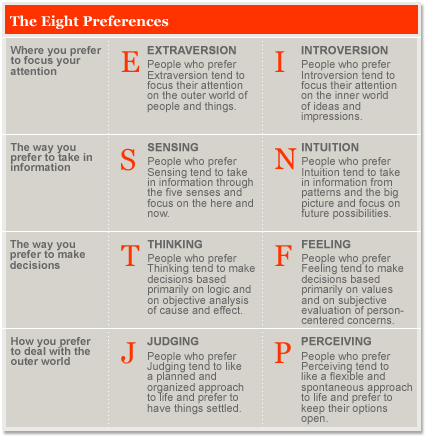
Source: Wikipedia: Myers Briggs Type Indicator
Personally, I was first exposed to the MBTI as a college undergraduate, where I actually studied psychology as a major (I only pursued financial services after I graduated because I needed a job and didn’t want to become a psychologist!). At the time, I found it incredibly illuminating to have better perspective on who I was, what I tended to enjoy (and not), and validating to understand that while I knew I tended to tackle problems and make decisions “differently” than many around me, that it was simply a reflection of my personality type. And perhaps more importantly, to also recognize that when other people approached those same problems differently, it was a reflection of their personality type. And that by understanding both perspectives and how they were different, it became much easier to navigate some problems and conflicts, especially in team situations.
For instance, I found in my MBTI results that I am a strong introvert – a challenge in a world where outgoing extraversion seems to be the perceived “ideal” for social situations. Yet the recognition of MBTI (and a lot of subsequent research about introverts as well) is that introversion doesn’t necessarily mean being doomed to a life of social awkwardness; instead, it’s simply a recognition that I am more comfortable in smaller intimate group settings, and not large gatherings and loud parties. Even to this day at a conference or social event, you’ll likely find me in the furthest possible corner from the music and the noise, sitting in quiet and comfortable conversation with just one or a few people.
Similarly, my MBTI results reflected that I tend to prefer a flexible approach to life and decisions, in a world where many people prefer a more planned and organized approach. As with introversion versus extraversion, the point is not to reflect that one is “right” or “wrong”, but understanding that someone you’re working with prefers one when you prefer the other can be valuable for either giving your teammate or employee what they “need” to be successful and respecting their different approach (e.g., recognize that if you prefer flexibility and your staff prefers a planned and organized approach, there may be a lot of friction if you don’t acknowledge the difference and find compromises where appropriate!).
Of course, some of my MBTI results weren’t entirely a surprise, at least to me. I have a strong leaning towards thinking over feeling (I prefer to drive my decisions from logic and objective analysis, sometimes to the point of being “annoyingly” rational!), and I tend to focus on the big picture and future possibilities (built from my intuition) when taking in information.
Overall, my MBTI results are shown below.
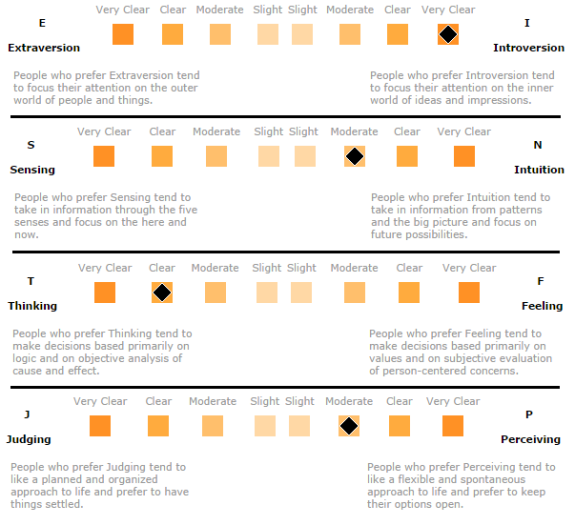
Notably, while I’ve personally found the MBTI to be very helpful to understand myself, and to have better perspective on those around me, the Myers-Briggs has almost no predictive value on things like your happiness and success, or job performance. My situation itself is probably a good example: I’m an introvert who is a professional speaker in front of large audiences, and a flexible “Perceiver” who lives a rather regimented and structured schedule to manage the breadth of my businesses and activities. Probably not a path that my MBTI results would have implied; nonetheless, I’ve been able to leverage my Thinking and Intuition skillset into opportunities that have advanced my career and businesses, and am quite happy with what I’ve been able to do.
So be certain not to overgeneralize the MBTI results to shoehorn yourself (or your partners, team, or staff) into a particular role on the basis of their MBTI type. Nonetheless, for gaining perspective on your own personality type, and getting a better understanding of how to interact with others (of different types), I’ve personally found the insights of the MBTI quite useful over the years.
Action Steps: If you’re interested, you can take an online version of MBTI here for $49, or a version here for $175 that includes an hour of consulting about the results and how you can apply them in your life/business. There are also some basic free versions of the test (this is most popular free site for identifying your Jung Typology) but the ‘authentic’ versions of MBTI (with some cost) are the ones I’d recommend, as the test instruments have been vetted far more rigorously (it’s estimated that roughly 2 million people take the fully licensed MBTI test each year). The MBTI is a series of 93 short questions to respond to (things like “which of the words in this pair best describes you”) and takes about half an hour to complete.
Kolbe A Index And Conative Strengths
While the MBTI is nominally a “personality test”, the Kolbe Index bills itself as a measure of your “conative strengths” – in other words, a focus on your natural instincts for how you think through and tackle problems to arrive at a solution. It’s intended to describe your problem-solving “M.O.” (modus operandus). The point is not to reflect that one problem-solving approach or instinct is better than another, but simply to recognize that different people solve problems differently; failing to recognize this can become problematic for teams (or outright lead to blind spots), while understanding it help a better team to be constructed, and/or ensure that the “right” people are in the “right” role for their natural talents.
The Kolbe looks at instinct-driven behaviors on four dimensions, or what Kolbe calls “Action Modes”, which are:
Fact Finder – the way we gather and share information
Follow Thru – the way we arrange and design
Quick Start – how we deal with risk and uncertainty
Implementor – how we handle space and tangibles
Each dimension is scored on a scale from 1 to 10, where “high” scores tend to indicate the person uses that approach to initiate solutions, while a “low” score indicates the person focuses on that dimension to prevent problems. Thus, the point is not that high scores are “good” or low scores are “bad”, but simply that they describe different problem-solving behaviors (in fact, Kolbe consultants prefer not to characterize these as "high" and "low" at all but simply as different points on a continuum). Final scores are typically grouped into bands (e.g., Fact Finders 1-3 are in the "Preventative" category, 4-6 are "Accommodating", and 7-10 are "Initiating"), and across the four dimensions this leads to 12 ways that people address problems, where any individual tends to use one of four (based on their individual scores).
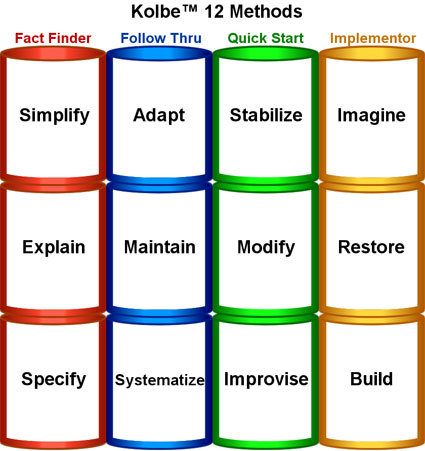
Source: Kolbe: Twelve Ways To Solve Problems
I became familiar with the Kolbe test fairly early in my career, and didn’t really get to know it well until we began to use it in our New Planner Recruiting business to help ensure that the planners being hired were a good match for the job description of the firm and the people they’d be working with (in particular, the advisor/boss to whom they’d be reporting). Unlike the MBTI, which provides interesting reflections on personality but is not necessarily very predictive of actual on-the-job behaviors, there is far more research to support and validate Kolbe’s use in the workplace, and I’ve found it very accurate regarding what I tend to do (and don’t do) in tackling challenges. My personal Kolbe Index results are shown below.
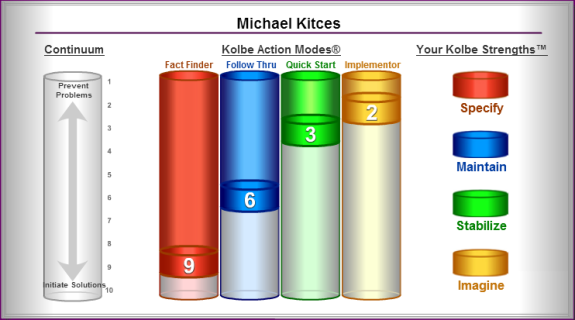
Perhaps not surprising – and in support of my prior MBTI results – my problem-solving approach is driven primarily by a desire to “fact find”. I study and analyze problems extensively before I’m comfortable and willing to take action. Supporting this dynamic, the Kolbe results also recognize that I am not a “Quick Start” – I don’t tackle problems by just diving in an improvising my way through, and instead prefer to stabilize the situation first. It’s no coincidence that my partner in XY Planning Network has dubbed me the “Director of Slowing Things Down”! My Kolbe results also reflect the fact that I prefer to “Imagine” my way through the problems, than be the one who actually goes hands-on to build the solutions; accordingly, over the years I’ve worked hard to put myself in the position of having great partners in all of my various businesses, who DO have a skillset at improvising and building, to complement the areas in which I know I am the weakest.
And in point if fact, that outcome is probably the best demonstration of the value of using the Kolbe Index – it helps you to understand both your strengths (to focus on them) and your weaknesses (to partner or hire others to help fill them in). This is notable, because the reality is that we like to hire people who are just like ourselves – a form of “mini-me” – when in truth most advisors would have far better results by finding someone to complement them, not mimic them. For instance, a strong Quickstart who likes to improvise their way through problems might be best served by having a partner who is a high Fact Finder who can round out the evaluation of a business decision, and then have a staff member who is a high Follow Thru who can ensure that is it done becomes systematized as part of the business. A group of Quickstarts without anyone to complement them may keep changing too quickly to ever get a business in place, while a group of Fact Finders may study an idea to death but struggle to take the initiative to move it forward. In fact, beyond the Kolbe A Index (which is for individuals), there are additional Kolbe diagnostic tools built specifically to evaluate overall teams and identify their strengths, weaknesses, and potential gaps.
Action Steps: The Kolbe A Index is a relatively quick 36 questions and generally takes no more than about 20-30 minutes to complete. You can get a basic diagnostic test of your Kolbe conative strengths on the Kolbe website, or work with a Kolbe Certified Consultant to get the test and some assistance in interpreting the results. There is also a paired Kolbe B (for employees) and Kolbe C (for supervisors) assessment to evaluate a small team. Our New Planner Recruiting firm also offers team performance consulting for those who want to put a larger staff group (5 or more people) through Kolbe and better understand the overall team’s strengths and potential gaps.
StrengthsFinder by Gallup
 The StrengthsFinder assessment was developed by Donald Clifton (known as “the Father of Strengths Psychology” and the research team at Gallup, and became known with the 2001 management book “Now, Discover Your Strengths” by Marcus Buckingham and Donald Clifton. The Gallup researchers have continued to deeper the tool over the past decade, and in 2007 released a new edition of the assessment tool and program, accompanied more recently by the updated book “StrengthsFinder 2.0” that discusses the latest version of the tool.
The StrengthsFinder assessment was developed by Donald Clifton (known as “the Father of Strengths Psychology” and the research team at Gallup, and became known with the 2001 management book “Now, Discover Your Strengths” by Marcus Buckingham and Donald Clifton. The Gallup researchers have continued to deeper the tool over the past decade, and in 2007 released a new edition of the assessment tool and program, accompanied more recently by the updated book “StrengthsFinder 2.0” that discusses the latest version of the tool.
The basic concept of StrengthsFinder is best understood by distinguishing it from the “traditional” approach to training and development. The traditional approach is to recognize that people have strengths and natural gifts, and weaknesses that need to be “fixed” or improved upon (with training, practice, help, etc.). By contrast, the StrengthsFinder approach is about focusing on areas where individuals already have natural strengths, and having them further build upon those strengths which will be easier to develop (and to match them to roles within the business that can best capitalize on those strengths).
The StrengthsFinder researchers have ultimately identified a list of 34 core strengths – or what they call “Talent Themes” – and the primary results of the assessment tool provide people with insight about their top 5 core strengths. The strengths can also be grouped together by the types of leadership they represent, from those who are good at “executing”, at “influencing”, at “relationship building”, and at “strategic thinking”. Recognizing that most people only have a limited number of strengths, a key aspect of StrengthsFinder in the context of leadership in particular is that good leadership teams will have people who can draw on all of these categories.
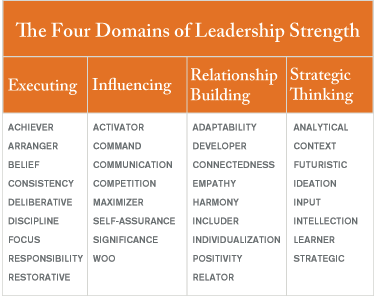
Source: Gallup: What Makes a Great Leadership Team?
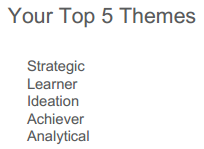 I first became aware of the StrengthsFinder assessment in the context of some research I was doing on the Positive Psychology movement (which shares a lot of overlapping principles), and as with most other assessments here, took it to get some fresh perspective on where my strengths lie. The results for my “Top 5” themes are shown to the right.
I first became aware of the StrengthsFinder assessment in the context of some research I was doing on the Positive Psychology movement (which shares a lot of overlapping principles), and as with most other assessments here, took it to get some fresh perspective on where my strengths lie. The results for my “Top 5” themes are shown to the right.
Again, the StrengthsFinder results seemed to reinforce some of the prior assessments discussed, but with some interesting additions. As with Kolbe, the StrengthsFinder results noted that I am Analytical and a Learner, and that I enjoy the imagine/Ideation part of the process. The results also reflected my strong “Achiever” drive and that I take great satisfaction in being busy and productive (which is certainly true!), and overall highlighted my Strategic theme.
In fact, the greatest takeaway I had from StrengthsFinder overall was my Strategic focus – four of my five strengths fell in the Strategic Thinking area (the 5th as “Achiever”, in the Execution category). This suggests that my best roles are the ones where I can focus on strategic issues, which again explained a lot to me about why I have gravitated to positions of leadership where I can play a forward-thinking role. In recognizing this aspect of my unique strengths, I have spent several years trying to continue to focus my time and role in my various businesses, seeking to work with partners where I can hone in on the strategic aspects of the business, and leave other parts to those who have strengths better suited to those roles and needs of the business. This is the whole point of the StrengthsFinder approach – to focus your time in the roles and areas where you have strengths, and refine those skills (which should develop more easily), rather than trying to fit square pegs into round holes by trying to shore up weaknesses in areas that just aren’t natural for you and never will be.
 Action Steps: You can purchase the StrengthsFinder assessment directly from the Gallup Strengths Center, with a charge of $9.99 for a report on just your top 5 strengths, or for $89 you can have a report on where you stand for all 34; the assessment itself has 180 questions and takes about 45 minutes to complete. Alternatively, if you purchase the “StrengthsFinder 2.0” book (which is $28 on Amazon but was recently as much as 48% off), you receive an Access Code with your purchase to take the StrengthsFinder assessment and get a report on your top 5 strengths (which makes it only slightly more expensive than buying the report alone, and you get the book that goes into greater detail on the 34 themes as well).
Action Steps: You can purchase the StrengthsFinder assessment directly from the Gallup Strengths Center, with a charge of $9.99 for a report on just your top 5 strengths, or for $89 you can have a report on where you stand for all 34; the assessment itself has 180 questions and takes about 45 minutes to complete. Alternatively, if you purchase the “StrengthsFinder 2.0” book (which is $28 on Amazon but was recently as much as 48% off), you receive an Access Code with your purchase to take the StrengthsFinder assessment and get a report on your top 5 strengths (which makes it only slightly more expensive than buying the report alone, and you get the book that goes into greater detail on the 34 themes as well).
In the end, you may not necessarily find anything in these personality assessments that you couldn’t have already figured out about yourself with a bit of self-reflection. But not everyone has the time – or the natural inclination! – for such introspection, and in some cases we can get ourselves “stuck in a rut” to the point where we lose all perspective on the challenges that we’re facing. If you’re finding you’ve hit a dead end in your own career or personal development, the insights from this tools may give you a better understand of what’s not-quite-right about your current role and how you’re spending your time, and where you might shift yourself to find more happiness and success.
For many, though, the best use of these tools is not for what they can learn about themselves, but what they can learn about their staff, their partners, how to work more productively as a team by utilizing each others’ strengths, and understanding where the weaknesses may be. Many firms use these kinds of assessment tools in the hiring process, specifically to ensure that the person being hired is a good match to the job description and the team in which they’ll be working; I’m certain that using these tools (especially Kolbe) has been a factor in the extremely low turnover rate we’ve seen amongst associate planners we’ve recruited in New Planner Recruiting, and I’ve begun to use the tools internally for hires in some of our own businesses and have never been happier with our hiring results.
Of course, no personality assessment will be perfect, and sometimes the results may disagree from one tool to the next; human beings are complex, after all, or as Walt Whitman once said, “Do I contract myself? Very well, then I contradict myself, I am large, I contain multitudes.” Nonetheless, the reality is that left to our own devices, we are no better at assessing people; in fact, we’re often worse, hiring those with whom we find rapport because they’re just like us, instead of those we really need who complement us by rounding out our weaknesses instead.
So hopefully, these tools will be helpful to you in your own firm… or perhaps simply for getting your own business or career path back on track to a happier and more successful place!
So what do you think? Have you ever used any of these personality assessment tools, either personally or in your business? Were the results useful? Do you have another tool that you prefer to use? Please share your thoughts in the comments below!





Michael..Awesome blog that explains each of the personality profile tests in detail with clear examples by showcasing your own results across the tests! This makes it all the more easier to understand the tools and their roles to build our practice better. It is such a coincidence that over the last 3 weeks, I have been doing some research on all the personality profiles tests to understand and make a decision to take the test forr myself and my teammates. Your blog was the best that I have ever read on the subject! Thank You so much for taking your time to put together a wonderful perspective on each assessment tools. Clearly, this is the need of the hour for growing firms and ensure that we have better fits for the firms who will enjoy their work with teammates because they will be able to play to their strengths and complement each other that will help build awesome teams in firms.
We are going ahead with all the three tests MBTI, Kolbe and Gallup’s Strengths Finder 2.0 with our current as well as for our future hires from this month onwards! One another test that was mentioned to me by one of my close friend is the ‘ Blue Ocean’ Personality test which helps assess personality profiles between partners in business. Have you heard of it? If so, do you think this test can be applied across teammates or restrict it to only between business partners and potential business partners.
Thanks once again for the great piece! I am so grateful and delighted to have come across the topic as the timing couldn’t have been better!
Michael–excellent summary! I have used the Kolbe and Strengths Finder since 1995, and together they work. The two have also helped me better understand my spouse of 37 years, who has a very similar MBTI profile. I have also used them when mentoring my own kids and some 20 and 30 somethings recently.
We are in the process of hiring another advisor. We were ordering a coupon for a candidate to take the Kolbe A before coming in for an interview. I learned from the Kolbe people that we cannot use the Kolbe, MB, Strengths Finder or other tests as stand-alones or we run afoul of Federal employment rules and risk a lawsuit. Rather, you need to have some rational and written criteria in place beforehand, such as the profile you are seeking. Thus, we are now going through Kolbe’s “Right-Fit” process to better identify the Kolbe profile of an ideal candidate. It is, however, okay to use the Kolbe after the individual is hired but it cannot be used as a criteria in the hiring process without some advance scientific criteria.
Finally, I’m not an introvert, but once of my introvert friends posted this helpful graphic on Facebook to help be better understand them. http://twentytwowords.com/a-simple-explanation-of-how-to-interact-with-introverts/
Hi Michael,
I appreciate your, thorough as usual, discussion of assessment tools. In preparation for
serving our business partner clients, my partner and I tested out many assessment tools. We started out very skeptically but had remarkably consistent results. We settled on using a version of DiSC (also based on the Jungian types in MBTI, but focused on behaviors rather than personality) from TTI Insights that offers the ability to map results across partners/teams, as well as prioritize motivations. It also helps when discussing roles since it indicates how partners are adapting away from their natural behaviors to conform to their role. In addition to the self-awareness that you noted, we see a lot of value in helping partners learn how to best communicate with each other based on the findings.
Partha, I do know of a tool called “Ocean” (though not Blue Ocean) which should be useful in assessing teams, not just business partners.
I, too, am an introvert and am relieved that introverts are finally being better understood. Susan Cain’s fairly recent book “Quiet” is a good one on this topic
Lisette,
Thanks for the feedback and kind words! I’ve had a little bit of experience with DiSC in the past as well, and is another one I’ve been looking at revisiting.
In terms of Susan Cain’s book, I’m a huge fan of it. I did a full article on it a few months ago at http://qa.kitces.com/blog/succeeding-as-an-introverted-financial-planner-amidst-the-extrovert-ideal/
Lisette..Thanks a lot for your response to the Ocean tool [ Oops..I mixed it up by mentioning it as Blue Ocean!] review. Great to know that we can use it to assess teams as well!
Excellent column, as it addresses some issues near and dear to my heart, in particular, the MBTI. As a former career counselor and a soon-to-be investment services professional, I am well versed in using the MBTI for career purposes. The publishers of the MBTI would caution all against using the tool in a selection manner as it was simply not designed to be used that way. Rather, a better use would be to use the results to create a training and education program that plays to a person’s natural abilities and tendencies. A strong Extravert might enjoy cold calling and canvassing business owners while an Introvert (like me) abhors the idea. I would be better suited to a less brute force method of prospecting. “J” types generally like structure while “P” types prefer to keep things fluid and open with deadlines coming as they may. I feel the true strength of the MBTI is not to find out who is likely to be a good advisor, but what kind of an advisor is someone likely to be.
Thanks for the chance to share!
Shawn,
Thanks so much for the comments and feedback!
I couldn’t agree more than MBTI seems better to fit some job roles/duties to the advisor, rather than determining “if” someone should be an advisor in the first place. There are a wide range of opportunities as a financial advisor, though it’s definitely true that not all types/roles are suited for all people! 🙂
– Michael
Thank you for sharing this very important information. A career counselor at age 39 determined that I am an INFP – very close to your archetype. He said that “my type is predominantly found in ashrams, social services and ministry – also in law”. So I actually found my perfect niche of in teh financial services industry as a financial planner and investment advisor in that the “F” – social worker” strenght really helps with client empathy, counseling and financial planning, and the “N” helps with seeing patterns and trends in the investment process. AND I need a strong deadline driven “J” in my life to help with organization and workflow processing.
Hi Michael, this is April Caudill. This is an excellent description of these tools. I’ve been a MBTI user for many years and completely agree with your analysis. Just took the Kolbe this week, which led to a search for more info and stumbling across your article. The highest compliment I can pay is that I printed it. 🙂 I hardly print anything, but I wanted to have it handy. I teach MBTI to the Society’s incoming national Board members each year, so I like your observations about how this impacts their work as financial professionals.
would recruiters prefer it if a job applicant include a copy of their kolbe index summary in their resume?
Ray,
It varies by recruiter. Some care a lot, some not at all.
I would probably note in a cover letter or on your resume that you can provide your Kolbe on demand, and/or mention what your primary Kolbe type is. Those who ‘care’ will ask for follow-up and your Kolbe report. Those who don’t will just get the takeaway you tell them. Win-win? 🙂
– Michael